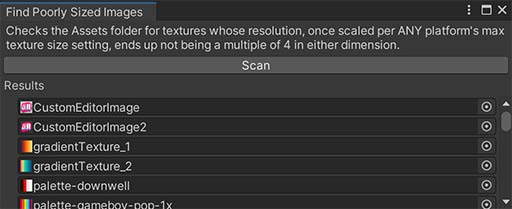Unity Editor Hack 3: Find Poorly Sized Images
This is an editor script which adds a menu button to open the below editor window.

Unity handles formatting and compression of JPG/PNG/other image files itself, as is necessary for cross-platform build support. It imposes some restrictions on the nature of your images to be able to compress them effectively. If those restrictions aren't adhered to, then compression can be disabled, causing the images to consume a singificantly larger amount of disk space. The specific rule that this script looks out for, is that some popular compression types are disabled if an image's width or height is not a multiple of 4.
The code will:
- Find all textures
- Get their texture importers
- Calculate their scaled image size
- Display images whose width or height is not a multiple of 4 in a list
using System;
using System.IO;
using System.Linq;
using UnityEditor;
using UnityEngine;
public class FindPoorlySizedImages : EditorWindow
{
// https://docs.unity3d.com/ScriptReference/TextureImporter.GetPlatformTextureSettings.html
static string[] _textureImporterPlatformList = new string[]
{
"Default", // Adding my own one here
"Standalone", "Web", "iPhone", "Android", "WebGL",
"Windows Store Apps", "PS4", "XboxOne", "Nintendo Switch", "tvOS",
};
[MenuItem("Search/Find poorly sized images")]
public static void ShowThis() => EditorWindow.GetWindow(
typeof(FindPoorlySizedImages),
false,
"Find Poorly Sized Images",
true
);
public static bool Check(string path)
{
var texture = new Texture2D(1, 1);
var bytes = File.ReadAllBytes(path);
texture.LoadImage(bytes);
var largest = Mathf.Max(texture.width, texture.height);
var textureImporter = TextureImporter.GetAtPath(path) as TextureImporter;
// Smile and nod for unsupported texture types (i.e. *.ttf) to keep `ScanDirectories` simple
if (textureImporter == null)
return true;
foreach (var platform in _textureImporterPlatformList)
{
TextureImporterPlatformSettings platformSettings = null;
if (platform != "Default")
{
platformSettings = textureImporter.GetPlatformTextureSettings(platform);
if (!platformSettings.overridden)
platformSettings = null;
}
// Fallback for "Default" or non-overridden platforms
if (platformSettings == null)
platformSettings = textureImporter.GetDefaultPlatformTextureSettings();
var width = texture.width;
var height = texture.height;
if (largest > platformSettings.maxTextureSize)
{
/* Inspector preview shows Unity rounding does NOT conform to `Mathf.Round`'s odd/even up/down behaviour:
* - 1024 x 5 reduced to max 256 = 256 x 1.25 = 256 x 1
* - 1024 x 6 reduced to max 256 = 256 x 1.5 = 256 x 2
* - 1024 x 7 reduced to max 256 = 256 x 1.75 = 256 x 2
* - 1024 x 10 reduced to max 256 = 256 x 2.5 = 256 x 3
*/
var mult = (double)platformSettings.maxTextureSize / largest;
width = (int)Math.Round(width * mult, MidpointRounding.AwayFromZero);
height = (int)Math.Round(height * mult, MidpointRounding.AwayFromZero);
}
if (
width % 4 != 0 ||
height % 4 != 0
) return false;
}
return true;
}
public static Texture2D[] ScanDirectories(string[] dirs) =>
AssetDatabase.FindAssets("t:Texture2D", dirs)
.Select(AssetDatabase.GUIDToAssetPath)
.Where(_ => !Check(_))
.Select(AssetDatabase.LoadAssetAtPath<Texture2D>)
.ToArray();
Vector2 _scrollPos;
Texture2D[] _results;
void OnGUI()
{
EditorGUILayout.LabelField(
"Checks the Assets folder for textures whose resolution, "
+ "once scaled per ANY platform's max texture size setting, "
+ "ends up not being a multiple of 4 in either dimension.",
EditorStyles.wordWrappedLabel
);
if (GUILayout.Button("Scan"))
_results = ScanDirectories(new string[] { "Assets" });
EditorGUILayout.LabelField("Results");
_scrollPos = EditorGUILayout.BeginScrollView(_scrollPos);
++EditorGUI.indentLevel;
if (_results != null)
{
if (_results.Length != 0)
foreach (var scene in _results)
EditorGUILayout.ObjectField(scene, typeof(UnityEngine.Object), false);
else EditorGUILayout.LabelField("Nothing found!");
}
--EditorGUI.indentLevel;
EditorGUILayout.EndScrollView();
}
}
This code doesn't consider the following aspects:
- Unity's In-built NPOT (not power of two) rounding feature, which (if enabled for an image) would guarantee that its resolution is compress-able
-
Whether mipmap generation is enabled or disabled
- If enabled, the resolution must be a power of two (rather than a multiple of 4) to be compress-able
- Performance
If I were to spend more time improving this, these are the key areas I'd work on:
- Support for including/excluding directories from the editor window
- Stagger the search so it doesn't completely block the editor